Showing the country the Bowling Capital of the World, Downriver-style
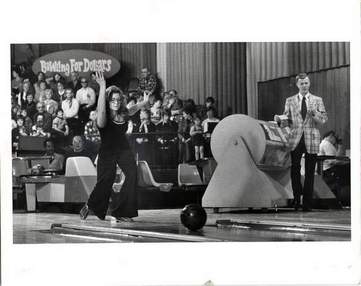 Bob Allison helms the 1970s version of Bowling For Dollars, taped in the arena area of Allen Park’s Thunderbowl Lanes. Of all the local shows produced around the country, it was Detroit’s (and Allen Park’s) which would become the telecasting standard. “Isn’t that Bob from Highland Park on Channel 4?” “Hey, I know her from down the block.” “They mentioned Woodhaven Stamping Plant on TV? Groovy!”One of the pure joys of “Bowling for Dollars”, which originally aired on WWJ Channel 4 in the 1970s, was that it was truly homegrown, literally predating the “Cheers” TV show line, “where everybody knows your name.” Before the days of public access television, Bowling for Dollars was the way for the average Joe or Jane to get noticed right in between the local news. One did not even have to be professional; bowlers of any experience or appearance could throw two balls down the alley at Thunderbowl Lanes, under the watchful eye of Bob Allison, and try to win a jackpot, or even dinner for two at Detroit’s Roostertail. Though the Detroit version was the most popular, the idea began in Baltimore, with the old-time TV standard “Beat The Champ” as its obvious influence. It began there in 1973 under the direct supervision of Bert Claster, best known for producing the kids show “Romper Room” (which also had localized versions airing in other markets).Bob Allison was aggressively recruited by Channel 4 to be the host, as a previous version hosted by the station’s weekend weatherman was not performing well in the ratings. Allison was offered the job as a chance to save the show from cancellation. 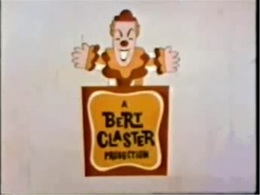 Claster Productions was also known for “Romper Room.” In addition to being initially reluctant to host due to hosting his widely popular radio standard “Ask Your Neighbor,” he was not a fan of the initial concept dreamed up in Baltimore. Upon meeting with representatives of Claster Productions in Baltimore, Allison differed with the general format of the show; the main sticking point being that too much time was spent introducing family and friends in the audience. He believed this took too much time away from the actual bowling to take place.Guaranteeing that, with some necessary revisions, the Detroit market show would end up being the prototype for other shows that would follow, Allison went on his radio show plugging the new TV show. His initial audience was undoubtedly many of his listeners from “Ask Your Neighbor,” but as word began to circulate, the viewership increased in droves. Keeping the atmosphere friendly, yet making the introductions briefer, the Detroit version indeed became the prototype Claster Productions would employ within months of its reboot. 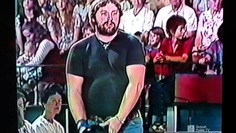 From the 1970s. The Detroit version would be the only one of the dozen-and-a-half airing which utilized a real bowling alley. Other stations built their lanes in the TV studio. WWJ did not have room to construct one, so after a small search, the production staff decided on Thunderbowl Lanes in Allen Park, one of Michigan’s largest. When trying to sell the idea to the proprietor, the production staff said they would handle the technical ends, while Thunderbowl would reap the publicity. “People will know your place,” they told him. The idea intrigued him and he gave the go-ahead. The shows would be taped in the Arena section of the center, which was built specifically for optimal television coverage.Allison’s version would have him welcome a contestant as he walked through the opening sliding door. He would then interview him for a minute or two, usually asking about career and hobbies. After introducing a couple members of the audience and selecting a Pin Pal from a machine, the bowling would begin. The competition was friendly and everyone seemed to enjoy the chance to impress their friends and neighbors. 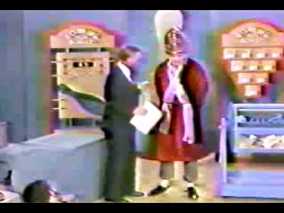 In a charitable cause, Detroit Free Press editor Neal Shine appears in the 1970s series dressed as a Catholic Pope. As Producer Laurie Olberman would recall, “Nothing stopped that show!” Not even the Blizzard of 1978, which seemed to strand everyone else at home or on the snow-covered roads. Preplanning had gone on inside the studios of Channel 4, and cast & crew were prepared to hunker down in a nearby motel overnight if need be. This would not bother the staff in the least, as they all enjoyed covering the show, even though a week’s worth of shows had to be taped in one afternoon, which required constant wardrobe changes and different studio audiences. It became the most-watched locally produced show in the history of Detroit television to that point, surpassing even Soupy Sales’ local heyday. And all the action came from Downriver! Television is a “business”‘ ; the alleys close for good in 1979 So what led to the eventual end of “Bowling For Dollars'” initial run? After four years, it is true the novelty did wear off some, but ratings were still topping some of the newscasts it was going up against. But it would end up being new management at WWJ-Channel 4 (who would change the call letters to today’s WDIV) who believed more money needed to be pumped into their newscasts, equipment, and the like. | 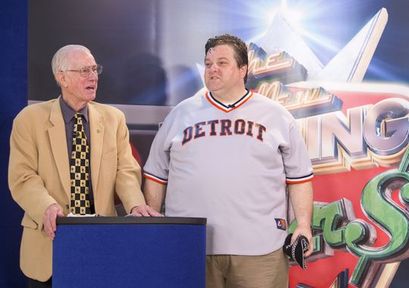 Bob Allison, radio’s “Ask Your Neighbor” since the 1960s, makes his television comeback in the 2013 return of Bowling For Dollars. Alongside him is participant #1: Pastor Steven Thrasher of Madison Heights. (Courtesy Jarrad Henderson, freep.com) Current and Former Downriver Bowling Centers The general Detroit area has been known as the Bowling Capital of the World for decades, once boasting more certified league members than any city in the world. Downriver, however, is not likely the best barometer of this. Although several hoses are still open, many have shuttered in the last twenty years. The list is below; the ones in boldface type exist today: 10 Pins of Trenton Bob Allison, radio’s “Ask Your Neighbor” since the 1960s, makes his television comeback in the 2013 return of Bowling For Dollars. Alongside him is participant #1: Pastor Steven Thrasher of Madison Heights. (Courtesy Jarrad Henderson, freep.com) Current and Former Downriver Bowling Centers The general Detroit area has been known as the Bowling Capital of the World for decades, once boasting more certified league members than any city in the world. Downriver, however, is not likely the best barometer of this. Although several hoses are still open, many have shuttered in the last twenty years. The list is below; the ones in boldface type exist today: 10 Pins of TrentonAllen Park Lanes Belmar Bowl Belmar II Lanes Biddle Bowl Clemente’sFlat Rock Lanes Indian Lanes Mulberry Lanes Pennsalt/Pennwalt Club Roosevelt Lanes Skore LanesSouth Lanes Sport Bowl Taylor Lanes Thunderbowl Trenton Lanes West Side RecreationWilwood Lanes Woodhaven Lanes Wyandotte Chemicals According to Laurie Olbermann, producer of the show in the 1970s, a contestant would roll two balls (the equivalent of one frame) If there were less than 5 pins down, contestant would win $5.00.If between 6-9 pins were down, contestant won that dollar amount.If a spare was rolled, the contestant would win $10 and dinner for two.If a split was converted, contestant would win two pizzas from Buddy’s.If one strike was rolled (but not two) contestant won prize from Pinboard.If two strikes were rolled, contestant won jackpot (began at $500.00)If returning contestant rolled three strikes, they would win appliances.If returning contestant rolled five strikes, they would win a Corvette.And according to producer Olbermann, the Corvette was won on a few occasions! |
By 1979, “Bowling For Dollars” was but a memory, and is likely known as the opening salvo in the eventual dissolution of local programming on the network level. But to its end, the Detroit version with a Downriver flavor still became the showpiece of the franchise wherever it was shown, and it was partly due to Bob Allison’s forthsight.
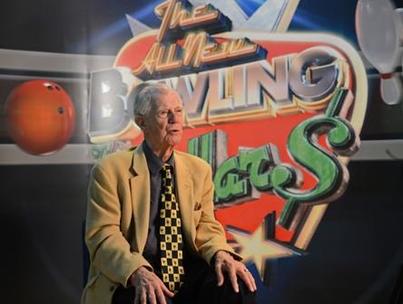
Bob Allison being interviewed in 2014 on the new set of Bowling For Dollars.
Nostalgic remembrances of this classic were answered in 2013 when Detroit independent station WADL announced a revival of Bowling For Dollars, the only market that has ever attempted a 21st century re-boot of the franchise to date. And once again, Bob Allison was tapped to be the host of the initial one-hour retrospective, with Thunderbowl Lanes again named the site; at the time they sported an all-new look to the Arena (which had replaced a nightclub which in turn stood on top of the original Arena surface).
After one season on WADL, Bowling For Dollars faded from memory again, not as likely to be recalled to memory many years from now as its 1970s predecessor. But there was literally no way to compare the two versions, nor was there any way to compare the Motor City’s version with others around the country.
From 1973 to 1979, Detroit got it right… with a generous assist from Thunderbowl Lanes… a Downriver institution. digitizing mclouth blog-forum